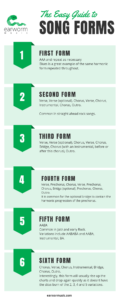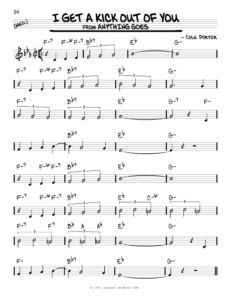Edited by Peter Muldoon – Original article appeared in Mouthzoff Magazine iss 9, 6 December 2013
Welcome to the third and final article on song forms. So far, we’ve looked at the first four of the six common forms found in popular music. Click here to go back to the beginning.
To recap; second, third and fourth forms use the familiar verse/chorus idea with either the simplest version of this, alternating the verse with the chorus, or with an added lift (pre-chorus), bridge or both. First form is the only other one we have covered that doesn’t use this concept with the simplest repetition of the same section throughout the whole song.
Now to look at Fifth form, First form was the same refrain (or A section) this one is a particular pattern of two section, AABA. This is a common form in musicals of the 20th Century and therefore a good chunk of the Jazz standard repertoire. Essentially, the majority of the song is made up of the A section with some relief in the form of the B section or Bridge. Usually each section is eight measures in length, making thirty two measures in total. The thing to keep in mind is that neither of these is a verse or a chorus, rather one or both usually contain the title. A common way of extending this form is to repeat the B and last A section, giving you AABABA, found a lot in Jazz ballads. In faster tempi, Jazz songs will usually repeat the AABA chord progression after the melody for solos before returning to the melody at the end.
Some instances where AABA is used to great effect – Brown Eyed Girl by Van Morrison and All The Things You Are by Jerome Kern.
Sixth form is a variation on the old verse/Chorus concept, yet is different because it hits you with the Chorus right from the start. It is interesting to note that this form can shoot up the charts very quickly but don’t sit up there as long as Third and Fourth forms. This is probably due to the catchy hook and title is right up front, but it can get worn out fairly quickly. There seems to be a lot more flexibility in this form, with some songs like Blake Shelton’s record of “Who Are You When I’m Not Looking” (chorus, verse, chorus, verse, verse, chorus) and Jason Aldean’s record of “Dirt Road Anthem” (chorus, four short verses, chorus, three short verses, chorus repeating) taking a few liberties. What ever works!
Steve Holy’s recording of “Good Morning Beautiful” and “Marry You” by Bruno Mars (Bruno Mars, Philip Lawrence, Ari Levine) are some popular songs that use Sixth form.
That’s it. I’ve given you an outline of the six commonly used forms: · First Form (AAA (repeat as you need)) · Second Form (Verse (Verse Optional), Chorus, Verse, Chorus, Instrumental, Chorus) · Third Form (Verse (Verse Optional), Chorus, Verse, Chorus, (Bridge) Chorus (with an instrumental before or after the chorus) · Fourth Form (Verse, Lift, Chorus, Verse, Lift, Chorus, (Bridge Optional) Lift, Chorus, Outro) · Fifth Form (AABA) · Sixth Form (Chorus, Verse, Chorus, Instrumental, Bridge, Chorus, Outro).
I hope this has shed some light on what is on the radio and given you some ideas for your own songs.
Missed something? Click here for all three articles in the series.

The Author
Sonic Edwards
Sonic is the author of two very dry books on Scale Fingerings for Bass Guitar.
He is also an in demand session musician and educator.



